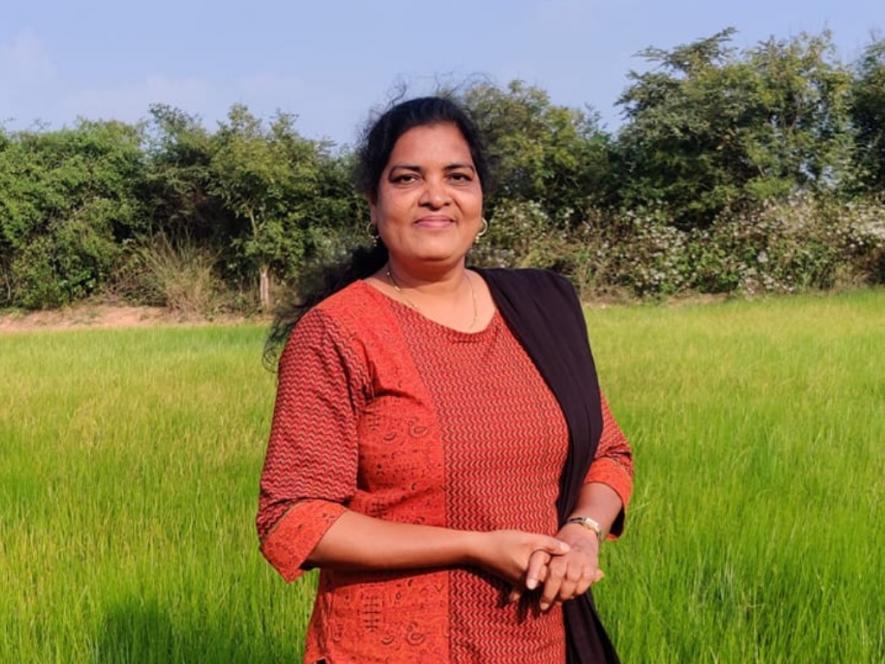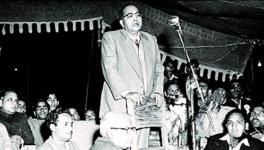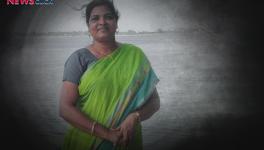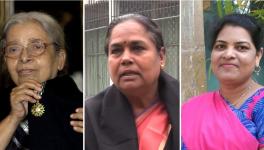“The Moment I Set Foot Outside My House, Caste Chases After Me Like a Dog”

Last month, the Oversight Committee of the Delhi University removed two of Sukirtharani’s poems from the English Honours syllabus.
Sukirtharani (b. 1973) is a poet and social activist known for her sharp critique of the caste system and the oppression of women. She has six collections of poetry to her credit: Kaipattri Yen Kanavu Kel (Hold my Hand, Listen to My Dreams); Iravu Mirugam (The Night Beast); Avalai Mozhipeyarthal (Translating Her); Kaamatthipoo (The Flower of Lust); Theendappadaatha Muttham (The Kiss of Untouchability); and Ippadikku Yeval (Yours, Eve). Her awards include the Devamagal Kavithoovi Award; the Puthumaipitthan Memorial Award; the Women Achievers Award, instituted by Pengal Munnani; the Avvai Award; the FETNA Award; and the Vibrant Voice of Subalterns Award. Her poems feature in college curricula across Tamil Nadu and have been translated into English, Malayalam, Kannada, Hindi and German. The much-appreciated short film, Kannadi Meen was based on her poem, Appaavin Nyaabagamaradhi (Father’s Forgetfulness). Sukirtharani was featured in the documentary film, She Writes, along with three other Tamil poets. She lives in Ranipet, Vellore district, and teaches Tamil in the government girls’ high school. She is currently working on a novel about Dalit life.
K Srilata and Swarnalatha Rangarajan (KS & SR): How and when did you start writing?
Sukirtharani (S): Before I answer this question, I think I should explain my background so that you understand my circumstances and contexts better. You are probably aware of the presence of caste in everyday life throughout the state of Tamil Nadu and the country. In most villages, divisions between Dalits and non-Dalits are a reality even today. Official records say that there are a little over six lakh villages in India, but in my view there are actually twelve lakh villages in all, because of the caste divide within each of them! The village I come from is also divided into two—the village proper and the Dalit area, or the cheri. These two areas exist in mutual exclusion. My social activism is motivated by the desire to unite these two divided sections. Various Dalit movements led by people like Ambedkar strove towards the goal of caste unity.
As Dalit students, we were segregated from the others during various class activities… The impact of that segregation continues to be a sharp, unhealed wound in my mind even today.
I am a woman who comes from a Dalit family that lives in the Dalit area of our village. My grandfather was a daily wage labourer, who worked in a factory owned by the Parry company [1] in Ranipet. My father followed in the footsteps of his father by working for the same factory. The practice of drumbeating (paraiadithal) was popular during festivals and funerals in our village. This work is performed exclusively by Dalit families in all villages, it is a practice that goes back several generations and was prevalent in my family, as well. It is not a full-time job, because festivals and funerals are seasonal and occasional events. This was the life, the context, into which I was born. I was the fifth child in my family. My father had studied only till the third or fourth grade, but he had a collection of couplets on ethics, political and economic matters and love. He always dressed impeccably, his clothes were clean and ironed, and we all learned how to dress from our father. I am saying this in order to debunk the stereotype that Dalits are poorly dressed and lack personal hygiene. I want to point out that this is a completely wrong and baseless notion.
When I was a girl, I had no interest in the kinds of games that the other girls of my village played. I preferred more adventurous games like nondi, [2] and always played and roamed the streets with the boys of my village. I climbed trees, played marbles and spun tops with them. I also enjoyed climbing mountains with the boys. As you know, this is not done using ropes or anything. I didn’t enjoy the typical girls’ games. People used to say I should have been born a boy but ended up as a girl! This is because the games that boys usually play are markers of masculinity. I had distinct masculine traits. People pointed this out to me frequently when I was still a child. My father was a fairly liberal man and allowed us many liberties, but they were carefully regulated. We did enjoy a lot of freedom but, at the same time, we knew our limits. My parents were liberal in that they allowed me to play with boys. Thanks to this, I learnt swimming and cycling but I was also expected to be back home by six or seven in the evening. I am talking about how things were some thirty-five years ago. Fathers were expected to maintain some order in their households. They were expected to be strict with their children.
There is one particular incident from this period that I want to highlight. There were always groups of children from different classes who travelled together to school. Those between the sixth and eighth grades belonged to one group, those from the ninth and tenth grades to another, and so on. Younger children, and this included me, formed a separate group. As Dalit students, we were segregated from the others during various class activities. We kept to ourselves and stayed aloof from the rest of the class—probably an unconscious decision. Nobody would take the initiative to approach us or talk to any of us. They all knew that we were from the Dalit area and so they kept their distance—it was a small village so everyone knew who came from which area. They would never accept anything from us. The impact of that segregation continues to be a sharp, unhealed wound in my mind even today. A non-Dalit girl once gave me a piece of candy in class. I got some money from my mother and bought a sweet for her the next day. But when I offered it to her in class, she turned away from me and refused to take it. This happened when I was at an age that was blissfully ignorant of the realities of caste difference. We thought everyone was alike.
That girl’s reaction upset and hurt me deeply, but I couldn’t comprehend the reason for it. I became properly aware of caste difference only when I was in sixth grade. Back then, the word ‘downtrodden’ (thazhtthapatta) was used to refer to those from the Dalit area of a village. These days, this umbrella term includes sub-castes such as Arundhatiyar, Adhidravidar and Pallar, terms that are used in community certificates and other official records. The word thazhtthapatta is deeply disturbing and offensive to the psyche. When I was in seventh grade, I started asking questions like, “What is the meaning of thazhtthapatta? Who caused these people to become ‘downtrodden’?” and so on. Children don’t have the maturity to think beyond such basic questions. I also became aware of the segregation of household duties on the basis of gender. Tasks like sweeping the floor and washing vessels were assigned only to girls, my parents never asked my brothers to perform these chores. When we went to sleep at night, my parents would ask us girls to spread the mats out and set everything up, they never asked my brothers to do so. At meal times, my parents made us girls collect the plates of male members of the family—this having to collect others’ plates made me feel particularly squeamish. I always wondered why men could not wash and put away their own plates like the rest of us. These differences in treatment, which is a reality in all households, was very much part of the way that ours was run. When we went to buy something, the shopkeeper’s body language when he accepted money or handed out the change also upset us. All these incidents left certain burning questions in my mind. To write about this was a difficult task at that age. My exposure to texts was also very limited as I had access only to school books till the tenth grade—my father’s salary at Parry could only sustain the basic needs of my family.
KS & SR: Did your parents encourage you to read?
S: My mother was a housewife. My father’s salary went towards feeding and clothing the eight of us—we were six children, including me. I have two elder sisters and two elder brothers, and my youngest sister was born seven years after me. My father, the sole breadwinner of the family, had to take care of the education of all six of us. As he was working in Parry, he was able to bring us notebooks, but textbooks were expensive and difficult to purchase. They were not easily available in those days. There were schemes that provided free textbooks to Dalit students, but they were not implemented properly—we could never get a hold of the entire set of five textbooks at one go. Sometimes we would get the Tamil or English textbook, but it was difficult to get a hold of social science, math and science textbooks. They were distributed very late in the academic year—January or February. For our reading, we relied entirely on our textbooks, because we did not have a library in our village and teachers were not really interested in introducing us to new books. Nor were they keen on libraries. Till tenth grade, my reading was entirely limited to school books. My elder brother had the habit of reading, he would read weekly and monthly periodicals. Magazines like Ranimuthu and Maalaimathi were very popular those days, he would buy those magazines and also some novels. Vimala Ramani, Vaasanthi, Lakshmi, Ramani Chandran and Rajesh Kumar were popular novelists of the time and I enjoyed reading their works. In our family, my brother and I were the only ones who read books. I started reading them only during my tenth grade and I wondered how people could write so well. Magazines like Rani, crime novels and pocket novels increased my interest in reading.
Dalit students continue to undergo isolation in school even today.
My parents were not highly educated. My father had studied only up to third grade and my mother till the sixth, but my father realised the importance of education and put all of us through school. People in our village would go around saying, “If you study, you should study like Shanmugam’s children.” It is a matter of pride that my siblings and I have all finished school, have graduated and are now in government jobs. From our village, not more than ten people (and this includes both the Dalit and the non-Dalit areas) have completed their education and found government jobs. Of these ten, six are from my own family.
For my secondary school education, I had to travel from my village to the town nearby. I was the only one from my village to do so. Children from my village usually don’t study beyond tenth grade. When I was in the tenth, there were only five girls in my class. People didn’t attach much importance to education those days, especially to the education of girls. When I started secondary school, I didn’t have any friends—students there already knew one another since they had been together from the beginning. I was a new girl from the village. Even in my village school, I had never had many friends, thanks to the caste system. So, on the whole, I have never had many friends. During the first fifteen years of my life, when friendship usually plays a significant role, I was without any friends. Those years passed by in a dark haze. Who will return those fifteen years to me? Nobody can. I am not alone in asking such a question. There must be others from similar backgrounds who feel the same. My observations as a teacher have shown me that Dalit students continue to undergo this isolation in school even today.
[…]
KS & SR: Why was poetry your favoured genre?
S: Unlike fiction, poetry doesn’t require a huge investment of time from the reader. A poet can enable the reader to enter the spirit of the poem by reading just a few lines. This is why I chose to write poems. My path was a difficult one, filled with tears and sorrow, and so I could never write about romantic love. I wrote instead about society and women. There were many other women writing poetry before I started writing. For the first time in my life, I got to visit Chennai. I had never ventured beyond Ranipet before. I never even had a photograph of myself until I got to tenth grade! Thanks to reading the poems of others, my worldview expanded. I read a lot of poetry at that time which gave me insights into choice of words, word arrangement and wordplay. I simultaneously pursued a BA degree in Tamil literature, followed by a Masters. I read a lot of old Tamil literature, Sangam literature, like Nattrinai, Kurunthogai, Ettu Thogai, Pathupattu,[3] and so on, as part of my course work. I was fascinated by the way Sangam literature handled language. That language, as you know, is quite different from the Tamil we speak today, it flows like a river without stopping. Sangam poets had a certain disposition called nerthi in Tamil. I use that word frequently and it means ozhunghu or order. Another meaning of the word would be beauty, azhaghu. The beauty of the language employed by those texts is something I really enjoy.
What unifies the work of all women writers is the subject of women’s oppression… our voices are politically charged arguments aimed at challenging oppressive forces acting against women.
KS & SR: There are certain common stereotypes about Dalit writers and women writers, they are criticised for writing from a place of anger. How would you respond to this kind of criticism?
S: Land, language, culture, tradition and heritage are factors that influence women’s writing. What unifies the work of all women writers is the subject of women’s oppression. Women who write about feminism or who are concerned about reforming society are not asking for your sympathy—our voices are politically charged arguments aimed at challenging oppressive forces acting against women. There is always a political statement in our poems. For instance, my poem, Viduthalay in Pathaagai (The Flag of Freedom) describes a situation in which a woman has been sexually abused and her body thrown into a canal. Had the poem concluded with a statement that the woman had been destroyed by all the atrocities heaped on her, it would not have been a poem. It would have been a typical plea for help, a cry for mercy. Instead, it ends on a strong note. The concluding lines are a whiplash. The statement I make is that even if you shove a stick up my yoni (vagina), I will emerge a stronger person. [4]
I may be the individual Sukirtharani when I write the poem, but I am part of the larger society once it is written. A poet is never an isolated individual.
When I read this poem at the Delhi Tamil Sangam, the audience responded with heavy silence. They couldn’t step out of this silence for quite a while because of the poem’s intensity, its truth. Perhaps it pricked their conscience. When our writing connects with people, it is a great honour. When people respond to it with silence, it is a sign that poetry has succeeded in its mission. That poem transported people at that event, at that specific place and time.
KS & SR: Your poem, Kolaiyum Seyvaal Parachi (The Dalit Woman Can Also Kill) is just as hard-hitting …
In most of my poems, there is a powerful sense of “I”, a strong subjectivity. I strongly feel the need to bring my sense of self into the picture. It is said that bringing the “I” repeatedly into one’s work is a mistake as it can crystallise into one’s ego. But the “I” which I use does not stand for Sukirtharani alone, it represents several women like Sukirtharani. This representative “I” is an integral part of my poems and so I must use it. If you take this particular poem, I would not have been able to express myself the way I did if I hadn’t used the first person. I may be the individual Sukirtharani when I write the poem, but I am part of the larger society once it is written. A poet is never an isolated individual.
[…]
KS & SR: What is your take on the necessity of identity politics?
I don’t particularly want to announce or declare my Dalit status all the time, but society forces me to do so, thanks to routine discrimination. Imayam [5], for instance, asks why people keep calling him a Dalit writer when there is no such category as a Nadaar writer or a Chettiyaar writer. He talks about the reality that is untouchability. I feel that I have no choice other than to use identity politics. When people keep referring to me as parachi (outcaste) to belittle me, I feel I must confront them by affirming my identity. There is a difference between the identity one takes upon oneself and the one that others force on to you. In my village, people continue to refer to us by offensive caste names, and terms such as parathevadiya or parathevadiyapasanga. [6] When I am at home, I don’t have to think about my caste, but the moment I set foot outside my house, caste chases after me like a dog. I am known as a “Dalit” teacher in my school. I seem to be carrying this burden on my shoulders without being conscious of it. This is something very characteristic of my life. Caste, therefore, seeps into the self I construct through my poems.
Notes:
1. East India Distilleries (EID) Parry Limited is a public company headquartered in Chennai. It manufactures sugar and bio-products.
2. Hopscotch.
3. Ancient Tamil literature of the period 300 BCE to 300 CE.
4. The lines are:
At the top of the pole planted in my vagina
the flag of our freedom shall fly painted in the colour of blood.
5. Well-known contemporary Tamil novelist, pseudonym of V. Annamalai.
6. Outcaste prostitute, a term of abuse.
Excerpted with permission from Lifescapes: Interviews with Contemporary Women Writers from Tamil Nadu by K Srilata and Swarnalatha Rangarajan, published by Women Unlimited, Rs 375.
Get the latest reports & analysis with people's perspective on Protests, movements & deep analytical videos, discussions of the current affairs in your Telegram app. Subscribe to NewsClick's Telegram channel & get Real-Time updates on stories, as they get published on our website.

















